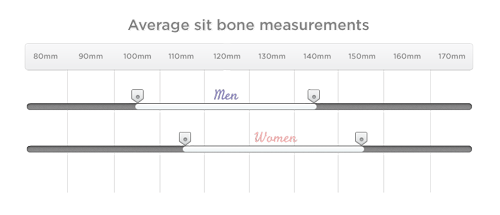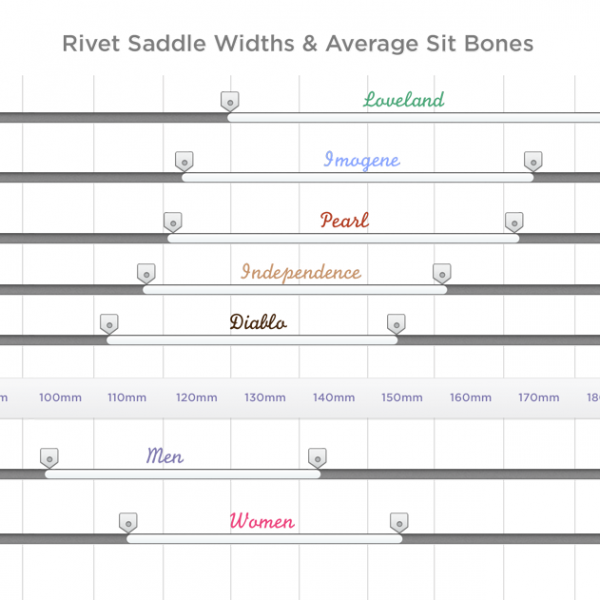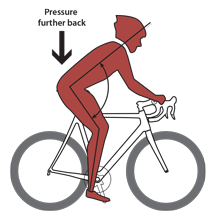Which Rivet is right for me?
This is, perhaps the most common question I am asked, “I am X years old, and I ride this – fill in the blank, many – miles a year/month/week. Which saddle is right for me?” An age old question and a good one. When I first started riding bikes, the saddle that came on the bike was the saddle I rode. What the heck did it matter? As I rode more and started doing longer rides, my personal undercarriage began experiencing a change. Longer distances = more pain. While this was in the era of “no pain, no gain”, I didn’t really give it too much thought. I could complete a century on a small racer-like sliver of a saddle. I had one saddle that I could ride for 60 miles, no problem, but on the 61st mile, my crotch would start swearing at me, and it wasn’t pretty.
My first season as a randonneuse really got me re-thinking my saddle. I needed to ride halfway across France and back on something I could sit on. And I can tell you, that while I did complete Paris Brest Paris that year, I spent about half of it in excruciating, burning pain from saddle sores that were categorized as second degree burns… in my crotch. Whew. The amazing thing is that everything healed up within a week (in good keeping with Lon Haldeman’s maxim, “If it will heal within two weeks, ride through it.”), and it put me on the search for a saddle I could ride long distances. While not everyone riding needs to find a saddle that will carry them 750+ miles in a short amount of time, why not find a saddle that will carry you that distance if you chose to go that far on your bike?
Sit Bones Measurements
Scientists have measured sit bone spacing for large populations. On average, men’s sit bone width ranges between 100mm – 140mm (give or take a few mm to round), and women’s range between 110mm – 150mm. Graphing these two averages shows an overlap of 30mm between men and women’s average sit bone spacing. This dispels the myth that saddles are gender specific, and the marketing hype that women must ride a wider saddle.
What this means for YOU is that it is worth your while to measure your sit bones in order to find a saddle that best matches your anatomy and your riding style.

There are plenty of ways to measure your sit bones, so I won’t go into them all here. Simply, you can do it yourself or have help from a friend, or spend a lot of money having someone do it for you. If you have a willing partner, use a measuring tape, assume the position and have at it! Or, if you are alone, place a piece of paper on top of a foam-like surface and sit down on it hard. Make sure you are sitting upright, which will push your sit bones into a vertical position. Your sit bones will leave an indentation on the paper. Use a measuring tape to measure the space between the indentations in millimeters not inches.
Once you have the measurement, add 2cm (or 20mm). Saddle width is approximate to sit bone spacing + 2cm. With leather saddles like a Rivet, you definitely want to add that 2cm, because you do not want to be sitting on the metal frame of the saddle. You want to be seated between the edges of the frame.
What if the saddle’s more than 2cm wider than sit bone spacing? You may experience rubbing/chafing on the inner thighs, and or extra pressure on your hamstrings. You may find yourself moving up onto the nose of the saddle, which will put more pressure on your soft tissue. Overall, too narrow is typically worse than too wide because the saddle will naturally migrate up into the pubic area filled with soft tissue and nerve endings.

This chart adds our three Rivet saddles and their range for riders. The Diablo, at 150mm wide is our narrowest saddle, the new Independence at 160mm wide is in the middle and the Pearl at 170mm wide is our widest saddle. This should help provide a rough guesstimate to determine which saddle might best suit you. But sit bone measurement is not the only aspect to consider.
Riding position

If you are a rider who spends most of their time on the flat portion of the handlebars and hoods, your sit bones are in a more upright position. This means that pressure will be more centralized around the sit bones and tissue surrounding it. The good news is, this tissue doesn’t have a lot of nerve endings in it and can/will toughen up with time in the saddle.
When you are on the hoods or in the drops your pelvis tilts forward (three degrees more for women then men, science tells us), which takes pressure off the sit bones and re-distributes it on the pubic rami or soft tissue area, which has many nerve endings. Women may experience more pain then men because the seat nose may migrate farther up in the pubic area due to the wider nature of their pelvic structure.
If you are riding long distances, it is always a good idea to move around on your bike. By this I mean, stand, stretch, move to the drops, up to the hoods, etc, to keep blood circulating. I personally ride in the drops quite a bit; I like flattening my back and I get more power from my legs when down in the drops. I don’t experience increased pain due to pelvis tilt because I tend to push harder while in the drops. The work my legs are doing is increasing force over the surface area of the saddle, reducing pressure on my body and concentrating it in my legs. When I am tired and am still in the drops, I can feel more pressure in my pubic area.

Firmness
Once a saddle is wide enough and you’ve thought about your riding position, it should also be firm enough. Leather saddles are designed as hammocks (the rear attaching to the metal frame, and the front of the saddle attaching to the nose piece), leaving most of the saddle to carry your weight, suspended in air. Thickness of the leather, how it’s treated plus design determine firmness and the length of time it will remain firm. This is individual preference and all of the leather saddles on the market will break-in with some time and attention. It is worth noting that saddles with too much sway make it more difficult for the rider to move around on the bike, as the sag or sway stops the rider from effectively tilting forward, centralizing pressure under the sit bones and making time in the drops less inviting.
Cut-outs?
Yes or no? Even on a saddle that’s wide and firm enough, some people need a cutout, because they suffer from discomfort with the soft tissue under their pubic bone. Leather saddles, with cut-outs help with soft tissue issues and save a bit of weight, but they risk firmness and saddle structure with the size and shape of the cut-out. Too large a slot and the saddle can lose shape and structure, too small and there’s no benefit to the rider.
Putting it all together
With these factors outlined, how does one finally make a decision? I have ridden all of Rivet’s saddles, and two out of the three feel good, and one feels great. My sit bones measure approximately 140mm wide. Add the 20mm and my measurement is 160mm. I ride over 12,000 miles a year, and move quite a bit around on my saddle. And I like to ride in the drops. I am very uncomfortable on the Diablo because I am sitting on the frame and can feel it. The Pearl has been my saddle of choice for the past 2 years, successfully riding another Paris-Brest-Paris and a host of other long distance events. I looked skeptically at the new Independence, thinking that it would be too narrow for me. I began riding the Indy last summer and once broken in, I find it to be more comfortable than the Pearl. I think, partially so because the nose is a bit narrower, so when I am in the drops, I feel no pain. Heck yeah!
In the end, it comes down to personal preference, riding style and of course, anatomy. And we haven’t even mentioned cost, weight or how it looks on your bike…but that’s another story. My hope is that you find the right saddle, because if you do, you’ll have more energy for all the great things that riding provides, instead of managing the pain in your ass. Best of luck in your search.
For the data and resources:
• Ischial tuberostiy spacing among men and women (PeopleSize 1998, http://www.openerg.com/).
• The four and a half rules of road saddles, Rinard, D. http://www.cervelo.com/en/engineering/ask-the-engineers/the-four-and-a-half-rules-of-road-saddles-.html.
• The illustrated guide to bicycle Seats, Joshua Cohen.
• Why it’s hard to find a good saddle, Ploeg, et al. http://www.activebody.org/Womens_group_PDF/ploeg_saddle_v3.pdf.
